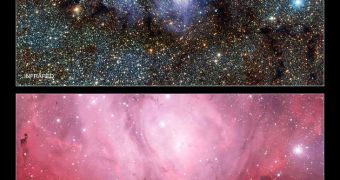Astronomers at the European Southern Observatory (ESO) announce that they managed to snap one of the most interesting images of the Lagoon Nebula to date, as part of a larger survey that seeks to monitor our galaxy for the next five years.
For the work, the researchers are using the Paranal Observatory's VISTA (Visible and Infrared Survey Telescope for Astronomy) instrument, which is located in the Atacama Desert of Chile.
In fact, the new photo was snapped as a detailed depiction of a much larger image, which also contains the area around the nebula as well. That view is in turn nothing but a small feature of a tremendously-large survey, which seeks to analyzed the entire Milky Way.
VISTA is currently being used to observe our galaxy's central regions, which are filled with cosmic dust and hydrogen gas. The infrared observatory is perfectly-suited for such studies, which cannot be conducted using visible light telescopes.
The goal of the VISTA Variables in the Via Lactea (VVV) project is to image the structure of the central Milky Way in much more detail than before.
Imaging the Lagoon Nebula, located in the constellation of Sagittarius, between 4,000 and 5,000 light-years away from Earth, was part of the infrared portion of our galaxy's survey.
“Infrared observations allow astronomers to peer behind the veil of dust that prevents them from seeing celestial objects in visible light,” ESO experts say in a press release.
Recent data of the nebula indicate that it's still producing young blue stars at a moderate rate. Stellar nurseries such as this one are huge molecular clouds made of dust and gas, that collapse when they gather enough mass.
As this happens, the entire imploding mixture ignites under extreme friction, and gives birth to a protostar, which then goes on to consume, or accrete, surrounding gas. Until this happens, telescopes operating in visible light wavelengths cannot see insider nurseries.
“This is because visible light, which has a wavelength that is about the same size as the dust particles, is strongly scattered, but the longer wavelength infrared light can pass through the dust largely unscathed,” the ESA team operating VISTA says.
“VISTA, with its 4.1-meter diameter mirror is dedicated to surveying large areas of the sky at near-infrared wavelengths deeply and quickly. It is therefore ideally suited to studying star birth,” they add.
The ESO telescope is the largest and most advanced of its type in the entire world, which is why astronomers are fighting to get a chance to use it for their studies.
It is expected that it will complete a full IR survey of the Milky Way within the next five years or so, depending on other assignments it has, Space reports.

 14 DAY TRIAL //
14 DAY TRIAL //